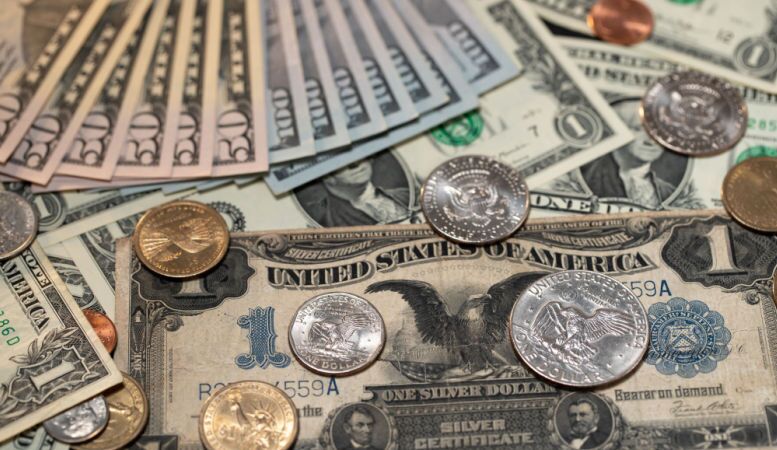Table of Contents
If you are new to currency collecting, you may not realize the benefits of owning silver certificates. Often, these historical items are worth much more than their face value. So how much should you expect to make selling a silver certificate?
To answer this question, our precious metals experts at Oxford Gold Group will discuss the history of these commodities. Consider the following information before you commit to buying these products.
What Is a Silver Certificate?
A silver certificate is a recognized form of legal tender (money) in the United States. In the past, it served as a paper currency representing a specific amount of real silver bullion. Certificate holders could use this item to buy silver without physically owning it.
When Did Silver Certificates Start To Roll Out?
Before the late 1800s, the United States government operated a bimetallic currency standard that designated silver and gold as legal tender. Although the U.S. government stopped minting silver coins in 1806, it still allowed citizens to convert their own silver into silver dollar coins. Economists call this practice “free coinage,” and it was an integral part of the early free silver movement of the 19th century.
However, a series of debates between banks, citizens, and miners regarding the fate of the nation’s currency sparked the 1873 Coinage Act. This legislation declared that Americans could no longer turn their own silver into coins.
The U.S. government began printing silver certificates in 1878 under the direction of the Bland-Allison Act. Around this time, a silver rush swept through the nation, particularly in states with multiple silver mines like California and Colorado. The act allowed individuals to deposit silver coins in exchange for paper bills.
The Effects of the 1873 Coinage Act and 1878 Bland-Allison Act
The use of paper currency became widespread despite initial public pushback. Unfortunately, the government did not foresee the inflationary consequences of printing this legal tender in large quantities.
As a result, silver certificates contributed to inflation in the mid and late 19th century. While representatives still fought for pro-silver policies throughout the coming decades, the gold standard eventually became the nation’s official monetary policy.
Paper money dominated the exchange of goods and services. In 1963, the nation feared a shortage of silver dollars and began phasing out the certificate.
In 1964, the U.S. government declared that citizens could no longer exchange their silver certificates for silver dollars. However, they could redeem silver granules with these items for the next few years.
How Much Is a Silver Certificate Worth?

What’s the point of owning a silver certificate if you can’t redeem physical silver with it? Simply put, these items are worth much more than they appear at first glance.
You can still purchase goods and services with most silver certificates. However, they are only redeemable at face value for cash. You will likely earn much more by collecting these items as sets and selling them at a higher price online.
Some of the first silver certificates are rare compared to other 20th-century Federal Reserve notes. A $1 silver certificate from 1896 could be worth hundreds of dollars on most markets.
Paper money is decomposable, and keeping these certificates in very fine condition can be challenging. However, silver certificates that retain their original material integrity can be extremely valuable. Other factors that determine the value of these items include:
- The Federal Reserve seal letter
- The serial number arrangement
- Face value
- Age
- Printing mistakes
1935 and 1957 Silver Certificates
The 1935 and 1957 series are two of the most common silver certificates you can find online. They closely resemble the design of a standard one-dollar bill.
These silver certificates have face values of $1, $5, and $10 in silver, payable to the owner.
Collectors sometimes call items like these “small certificates” because of their physical size and value. Because they are extremely common, they aren’t worth much.
Today, you can purchase these items for just over one dollar. In the best condition, they may be worth about five dollars.
1934 and 1953
A 1934 or 1953 silver certificate is worth about $7. Those collecting silver certificates may recognize these notes for the large blue seal they include on the right side.
1935 Hawaii Silver Certificate
As a way to demonetize paper money during a Japanese invasion, the United States started printing the 1935 Hawaii note with brown seals instead of the traditional red or blue. An uncirculated example of this item could sell for as high as $90.
1878 and 1923

Large certificates have denominations ranging in value from one dollar to one thousand dollars. Due to their rarity, they are generally worth much more than other notes. Some of them sell for as high as several thousand dollars.
The images of Abraham Lincoln and other notable figures appear on the 1878 and 1923 issues.
1896 History Educational Series
This silver certificate is one of the most sought-after notes. Very few of these extremely rare bills still exist.
The face value of this item is only $2. However, bids can reach as high as $3,000 in some online marketplaces.
The silver certificate includes the faces of Samuel Morse (inventor of the telegraph) and Robert Fulton (a significant figure in the steamboat industry).
1896-1923 Horse Blankets
A horse blanket note is a large silver certificate that you may need to fold several times just to get in your wallet. A complete horse blanket set also includes other legal tender notes like gold certificates and federal reserve money. Some online auction sites list the value of this set at nearly $6,000.
Why Were Silver Certificates Not Worth As Much as in the Past?
The federal government issued silver certificates originally redeemable for actual silver. Now you can only redeem these certificates for standard Federal Reserve notes. Consequently, the value of these commodities only reflects the demand of collectors.
Still, owning a complete set of silver certificates could be incredibly valuable.
How To Trade Your Silver Certificates for Cash

Suppose you want to sell a stack of $1 silver certificates. It’s best to partner with a reputable dealer to get the most money from your transaction.
Take your time researching. Many dealers who buy silver coins also collect silver certificates. However, be wary of pawn shops or amateur collectors who may not appreciate the real value of these items.
A reputable dealer can identify numerous factors that impact the item’s value. They will check the condition of each silver certificate and determine its age.
Once you know the value of your items, list them online. Auction sites allow you to accept the highest bidder.
How To Tell if Your One-Dollar Silver Certificate Is Rare or Counterfeit?
It’s rewarding to admire the artwork and design of a silver certificate. Today, these items symbolize a long period of historical significance.
Still, it can be challenging to determine if your one-dollar bill is rare or fraudulent without a trained eye.
A collector will inspect serial numbers to verify an item’s rarity and authenticity. A radar note is particularly attractive to collectors because it contains a palindromic number (the same serial number read both forward and backward).
Suppose you own an 1896 one-dollar bill in perfect uncirculated condition that also contains a palindromic serial number. The collector may determine the value of this bill to be much higher than the typical 1896 certificate.
In some cases, collectors find star notes that indicate a mistake in the printing. A rare star symbol at the beginning of a serial number can make any silver certificate worth more money. Reputable collectors will also be able to identify any key difference in design that indicates your item is fake.
Alternative Investments: Physical Silver Bullion/Silver Coins
Many investors find more personal value in purchasing precious metals like silver dollars instead of representative money.
Still, you could earn quite a bit of cash collecting entire sets of these items. As the years pass, silver certificates may increase in value. Holding on to these rare items could be a worthwhile investment.
At Oxford Gold Group, we help our customers understand the actual value of their items. Our site allows you to view and purchase the best gold, silver, and platinum products on the market. Explore our blogs to see how a precious metals IRA could boost your retirement funds.
Contact Oxford Gold Group in Beverly Hills, CA. Call 855-265-8037.








